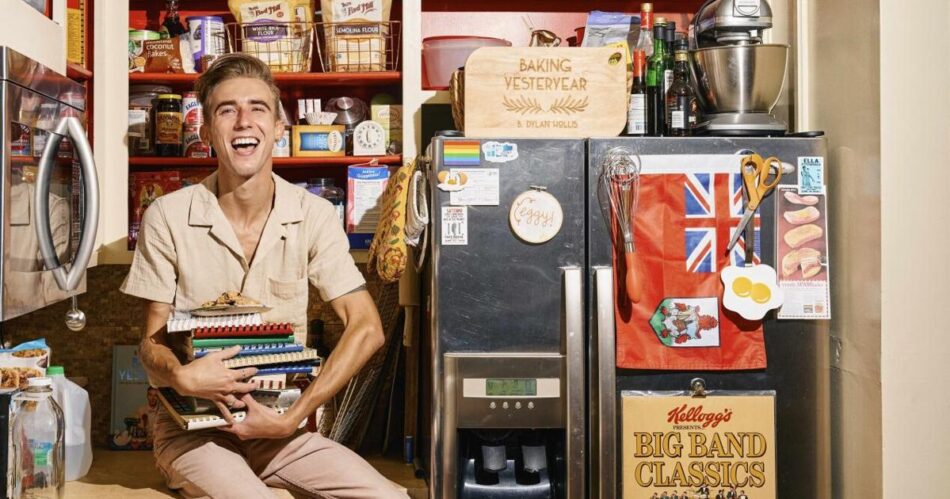B. Dylan Hollis left his native Bermuda to study jazz piano at the University of Wyoming in Laramie, where he now spends most of his time. During the pandemic, he started baking odd recipes from a 1915 cookbook he had found. His baking videos on @bdylanhollis took off. His 2023 cookbook “Baking Yesteryear: The Best Recipes from the 1900s to the 1980s” was a best seller. He followed up with the recently released “Baking Across America: A Vintage Recipe Road Trip,” which includes a stop in New Orleans. Hollis will talk about the new book and sign copies at 6 p.m. Friday, June 6, at the Academy of the Sacred Heart. Find information at gardendistrictbookshop.com.
Gambit: How did you get into baking on social media?
B. Dylan Hollis: I was not a baker. I didn’t know cooking. I could set fire to a pot of water.
It was all a product of the pandemic.
In 2020, I downloaded TikTok and started looking for ideas. I had been uploading TikToks and short videos trying to find something that stuck. I had always collected old things, and in my collections, I had a cookbook from 1915. An old Five Roses flour cookbook, and it had a wild recipe for pork cake. It was a fruitcake with a pound of ground pork in it. I wanted to show people it was a legitimate recipe. That became my thing.
Folks sent books to my P.O. box. I was finding weirder recipes in there and I uploaded them. In the process, I learned how to bake.
Cooking on social media is all very pretty. It’s doing things in a trendy, modern way. I had to turn it into something that would interest people. I don’t think the people that watch me are home cooks. No one is going to criticize me for the way I cook a pork cake. I focused on what I call my three W’s: anything that makes living wild, whacky or wonderful. Showcasing the whacky things in these recipes and making jokes out of them. It’s more from the perspective of entertainment through bad ideas from back in the day.
At first, it was the oddities — you go for the shock factor. But then I came across a recipe for a gooey butter cake. The story of it was something that started out flawed. Someone mixed up their ratio of flour to butter and created a failure in St. Louis during the Great Depression.
But the legend goes that people actually liked it. The online response was different. It was more pride. People were talking about it like the dish was their hero. That’s what made me realize that the classics had a following, a different type of gravitas. That’s when I realized it wasn’t just the shock factor that draws people. It also was nostalgia.
Gambit: What was your idea for “Baking Across America”?
Hollis: When I would do these recipes that were popular somewhere, the response was so loud. So it was like, there have to be more gooey cakes. Every state surely has to have their own recipes.
We didn’t photograph in all 50 states. We shot for half. We spent a great deal of time researching and using library archives.
How we did “Baking Across America” is we all landed in a place. We’d go to a store to get ingredients and cook them in an Airbnb.
It was my first time in Savanah, Georgia. It’s another place that feels set in time. It feels like the old South. It was nice to visit Yellowstone National Park. We had to put food in bear-proof bags to do photo shoots there. I didn’t know quite how old Boston was. You’re standing on the same ground the British camped on. You’re experiencing history brick by brick. It’s cool when you go to the birthplace of some of these things. The Parker House Hotel invented the Boston cream pie. We baked a Boston cream pie, and you’re standing in the place that invented it 100 years ago.
Gambit: What interested you from New Orleans?
Hollis: I was awestruck. It was my first time there. I had seen it through cookbooks. One of my first cookbooks was the reason I chose New Orleans as a place to photograph. In 2022, a fan sent me a 1900, first edition “Picayune Creole Cookbook.” Leather bound and falling to bits. But it is a tome. I needed to go there.
Landing in New Orleans, it doesn’t even feel like the United States. You’ve got the French Quarter and it looks like nothing else, it smells like nothing else. It’s a party. You go from street corner to street corner and there’s live music in all of these bars with their open windows.
It’s completely different, and so is the food. Everyone thinks of bananas Foster. I am obsessed with Brennan’s. It’s got this 1950s kitsch with serving (the dessert) flambeed.
Pralines are crazy. I got a lot of flack. I recorded a video on pralines. It’s one of the hardest recipes to get right. They’re on every street corner. I tried all of them, from Sally’s to everything. For pralines, it’s an amalgamation. I tried all these recipes and distilled it down to one really good recipe.
We got yelled at taking pictures of them on the streetcar. You’ve got plenty of cookbooks shot perfectly in a studio. We shot the photo of pralines on Prytania.
I knew about calas from the “Picayune” book. They were already talking about it like it was a lost art. Through conversation, we were told we had to go see the calas expert. So we did. We went to Treme and met Mr. Brandon Pellerin there. He taught us all about it. I am humbled.
The story of what these are and who owns this is far beyond me. I was going to take it out of the book because it wasn’t my story to tell. It’s the history of emancipation through food. But I was convinced to keep it in to feature it and put it out there and keep the name going. It’s its own page and I direct people to Brandon.








